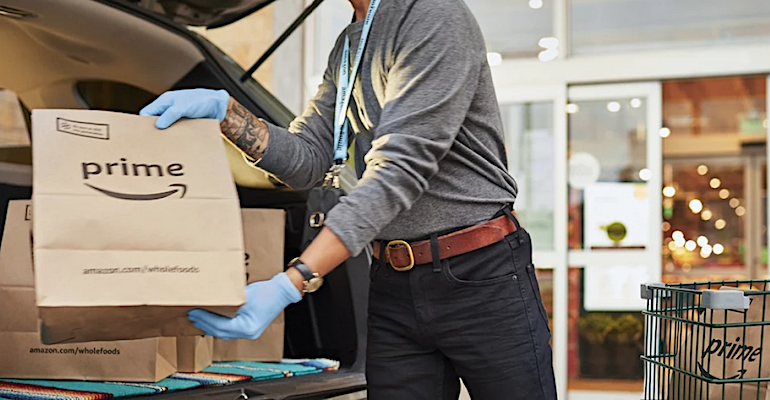After declines in January, U.S. online grocery sales in February rose 2.4% from sequentially and 8.5% versus a year ago, according to the latest Brick Meets Click/Mercatus Grocery Shopping Survey.
The U.S. online grocery market hit $8.7 billion for February, up from $8.5 billion in January and $8 billion in February 2021, strategic advisory firm Brick Meets Click said Thursday. February 2022 marked the seventh straight month that e-grocery sales were $8 billion or more following three consecutive months (May to July 2021) of sales at $7 billion or less. Monthly online grocery sales reached their high-water mark of $9.3 billion twice (January and March 2021) since the COVID-19 pandemic began in March 2020.
In February 2022, online grocery sales via pickup climbed 6% year over year to $4 billion, the same as in January. Delivery sales came in at $3.2 billion, jumping 37% from a year ago and advancing 6.7% month to month. Ship-to-home e-grocery sales continued to shrink in February, totaling $1.4 billion, down 6.7% from the previous month and 24% from a year ago.
Barrington, Ill.-based Brick Meets Click noted that ship-to-home now has the smallest online grocery sales share, at 16% in February, after having the largest share among fulfillment channels pre-COVID. Pickup garnered the biggest sales share for the month at 40%, with delivery close behind at 37%.

The grocery e-commerce user base remained approximately the same in February, with more than 68 million households buying groceries online during the month, down around 1% from 69 million in January but up about 11% from 60.1 million in February 2021. All three segments — pickup, delivery and ship-to-home — saw double-digit gains in their monthly active user (MAU) bases for February, with delivery generating the largest year-over-year gain at roughly 28%.
“New service providers, a broader range of retailers selling grocery-related products online, and services targeting faster cycle times contributed to delivery’s strong sales growth,” explained David Bishop, partner at Brick Meets Click, which focuses on how digital technology impacts food sales and marketing. “But even so, more shoppers still prefer pickup for range of reasons that will benefit this service model going forward.”
Fielded Feb. 26 and 27 conducted by Brick Meets Click, the study polled 1,790 U.S. adults who participated in their household’s grocery shopping and made an online grocery purchase in the previous 30 days. Delivery includes retailer and third-party services (e.g. Instacart, Shipt), while pickup includes in-store, curbside, locker and drive-up services. Ship-to-home sales cover online grocery purchases delivered by parcel couriers like Federal Express, UPS and the U.S. Postal Service.
Average order value (AOV) dipped more than 2% year over year in February, which might indicate fewer items in the online grocery basket due to ongoing price inflation, Brick Meets Click said. Ship-to-home drove much of the decrease, as that fulfillment channel’s AOV sank more than 25% year over year to less than $40 in February, while pickup had a 4% AOV decline. The delivery channel AOV, however, grew 12% for the month.
MAUs’ order frequency edged up to 2.73 orders in February, compared with 2.7 in both the previous month and February 2021. Brick Meets Click attributed the uptick to higher use of pickup and delivery, whereas ship-to-home turned in a mid-single-digit decrease in order frequency. Still, the advisory firm pointed out, MAUs completed marginally more orders this year versus last only in large metropolitan markets, and three smaller metro-market types had mid- to upper-single-digit declines in order frequency.
And after a slight decrease in January, the share of MAUs that cross-shopped online at mass merchants came in at nearly 26% in February, up 1.3 percentage points from a year earlier. In turn, the probability of online grocery shoppers to use the same service again within the next month rose over 4 percentage points year over year to more than 62% for the month. Brick Meets Click noted that the repeat intent rate for supermarkets overtook that for mass retailers for the second time in the past several months.
“Today, customer expectations for online grocery shopping are different than they were even a year ago, not to mention before COVID,” observed Sylvain Perrier, president and CEO of Toronto-based grocery e-commerce specialist Mercatus. “To grow their online share of wallet going forward, conventional grocers need to find ways to better satisfy those changing expectations. Inflationary pressures suggest retailers should look at optimizing online meal planning, showcasing store brands and encouraging repeat customers to take advantage of online loyalty discounts.”





